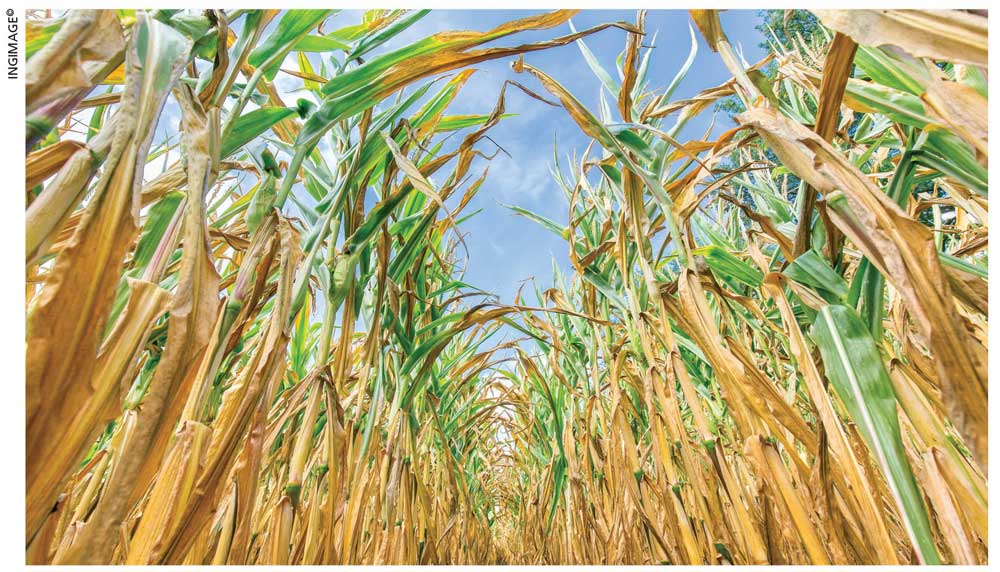AGRICULTURE SECTOR
CROPS UNDER THE WEATHER!
Akila Wijerathna explains why farmers must learn to adapt to climate change

Agriculture is particularly vulnerable to climate change due to its profound dependence on weather patterns, land, water and other natural resources. While shifts in climate could potentially extend growing seasons or facilitate the cultivation of different crops in certain regions, the overall impact is a complex interplay between benefits and challenges.
This sector has already implemented several practices such as crop rotation and integrated pest management to adjust to a changing climate. Ongoing research endeavours to enable the sector further in navigating evolving environmental conditions.
Sub-Saharan Africa, South Asia and Southeast Asia collectively house around 80 percent of the global population, and these regions are most susceptible to crop failure and hunger induced by climate change. Farming families, which are already disproportionately impoverished and vulnerable, face heightened risks.
Severe droughts triggered by phenomena such as El Niño and long-term climate change could plunge millions more people into poverty, even in relatively economically stable countries such as the Philippines and Vietnam. Their farmers are teetering on the brink of poverty and food price hikes are impacting urban consumers.
While elevated temperatures and increased CO2 levels can initially benefit crops, the subsequent acceleration of evapotranspiration poses a challenge.
Regions already grappling with water scarcity will witness escalating adverse impacts on production – including dwindling water supplies, heightened occurrences of extreme events such as floods and severe storms, heat stress, and an upswing in pests and diseases.
Beyond a certain threshold such as a 2°C increase in global temperatures, adaptation becomes increasingly challenging and costly. Countries with already soaring temperatures may experience more immediate effects on less heat tolerant crops such as wheat.
The lack of effective solutions and diminishing crop yields, particularly in the world’s most food insecure regions, threaten to drive more people into poverty. Alarmingly, an estimated 43 million individuals in Africa alone could fall below the poverty line by 2030 if proactive measures aren’t implemented to address the impact of climate change on global agriculture.
Adapting agriculture to the challenges posed by climate change necessitates a multifaceted approach that encompasses significant social, economic and technological transformations. Several key strategies can be employed to enhance resilience and reduce emissions.
Optimising water use through efficient policies and demand management is crucial. While expanding irrigation infrastructure may seem like a logical step, research indicates that for certain countries, future water supply might be insufficient for such systems.
Alternatives include meticulous water demand management and the implementation of advanced water accounting systems, as well as utilising technologies such as soil moisture sensors and satellite evapotranspiration measurements.
These measures enable practices such as alternate wetting and drying of rice paddies, conserving water and simultaneously mitigating methane emissions. Another strategy involves transitioning to less water intensive crops – for instance, rice farmers could consider cultivating crops such as maize or legumes that demand less water.
The pivotal role of soil health can’t be overstated in climate resilient agriculture. Increasing organic carbon content in soil enhances water retention and facilitates easier access to water by plants, thereby bolstering resilience against drought.
Mitigating the impact of climate change on agriculture requires a concerted effort at industrial and national levels.
At the industrial level, implementing sustainable agricultural practices is paramount. This includes promoting precision farming techniques, optimising water usage through efficient irrigation systems and encouraging the use of climate resilient crop varieties.
Investing in R&D to create innovative technologies that enhance agricultural resilience such as drought resistant seeds and precision agriculture tools is essential.
Educating and training farmers in climate smart practices can help facilitate widespread adoption.
On a national scale, policy measures play a pivotal role. Governments should formulate and enforce climate conscious agriculture policies that incentivise sustainable practices and provide support for farmers to adapt to changing conditions.
This may involve subsidies for the adoption of eco-friendly technologies, insurance schemes to mitigate the financial risks associated with climate-related crop failure and the establishment of early warning systems for extreme weather events.
Nations must work together to share knowledge, resources and best practices in combatting the adverse effects of climate change on agriculture.




